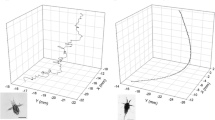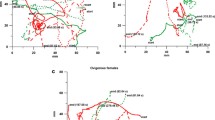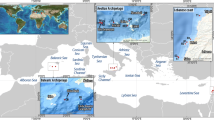Abstract
The degree to which behaviour, vertical movement and horizontal transport, in relation to local hydrodynamics, may facilitate secondary dispersal in the water column was studied in post-larval Sillaginodes punctata in Port Phillip Bay, Australia. S. punctata were captured in shallow seagrass beds and released at the surface in three depth zones (1.5, 3 and 7 m) off-shore at each of two sites to mimic the re-entrainment of fish. The behaviour, depth and position of S. punctata were recorded through time. The direction and speed of local currents were described using an S4 current meter and the movement of drogues. Regardless of site, fish immediately oriented toward the bottom, and into the current after release. In shallow water (1.5 m), 86% of fish swam to the bottom within 2 min of release. At one site, the net horizontal displacement of fish was largely unrelated to the speed and direction of local currents; at a second site, fish could not maintain their position against the current, and the net horizontal displacement was related to the speed and direction of currents. In the intermediate depth zone, wide variability in depths of individual fish through time led to an average depth reached by fish that was between the shallow and deep zones. Based on daily increments in the otoliths, however, this variability was not related significantly to the time since entry of fish into Port Phillip Bay. In the deepest depth zone, 81% of fish remained within 1 m of the surface and their horizontal displacement was significantly related to the direction and speed of currents. Secondary dispersal of post-larval fish in the water column may be facilitated by the behaviour and vertical movements of fish, but only if fish reach deeper water, where their displacement (direction and distance) closely resembles local hydrodynamic regimes. In shallow water, fish behaviour and vertical migration actually reduce the potential for secondary dispersal.






Similar content being viewed by others

References
Armsworth PR (2000) Modelling the swimming response of late stage larval reef fish to different stimuli. Mar Ecol Prog Ser 195:231–247
Bruce BD (1995) Larval development of King George whiting, Sillaginodes punctata, school whiting, Sillago bassensis, and yellow fin whiting, Sillago schomburgkii (Percoidei: Sillaginidae), from South Australian waters. Fish Bull 93:27–43
Caley MJ, Carr MH, Hixon MA, Hughes TP, Jones GP, Menge BA (1996) Recruitment and the local dynamics of open marine populations. Annu Rev Ecol Syst 27:477–500
Christy J, Morgan S (1998) Estuarine immigration by crab postlarvae: mechanisms, reliability and adaptive significance. Mar Ecol Prog Ser 174:51–65
Cummings V, Pridmore R, Thrush S, Hewitt J (1995) Post-settlement movement by intertidal benthic macroinvertebrates: do common New Zealand species drift in the water column. NZ J Mar Freshw Res 29:59–67
Doherty PJ, Williams DM (1988) The replenishment of coral reef fish populations. Ocean Mar Biol Annu Rev 26:487–551
Dudley B, Tolimieri N, Montgomery J (2000) Swimming ability of the larvae of some reef fishes from New Zealand waters. Mar Freshw Res 51:783–787
Etherington LL, Eggleston DB (2000) Large-scale blue crab recruitment: linking postlarval transport, post-settlement planktonic dispersal, and multiple nursery habitats. Mar Ecol Prog Ser 204:179–198
Fowler AJ, Black KP, Jenkins GP (2000) Determination of spawning areas and larval advection pathways for King George whiting in southeastern Australia using otolith microstructure and hydrodynamic modelling. II. South Australia. Mar Ecol Prog Ser 199:243–254
Heath M, Zenitani H, Watanabe Y, Kimura R, Ishida M (1998) Modelling the dispersal of larval Japanese sardine, Sardinops melanostictus, by the Kuroshio Current in 1993 and 1994. Fish Oceanogr 7:335–346
Hindell J, Jenkins G, Keough M (2002) Variability in the numbers of post-settlement King George whiting (Sillaginidae: Sillaginodes punctata, Cuvier) in relation to predation, habitat complexity and artificial cage structure. J Exp Mar Biol Ecol 268:13–31
Hixon MA (1998) Population dynamics of coral-reef fishes: controversial concepts and hypotheses. Aust J Ecol 23:192–201
Jenkins GP (1986) Composition, seasonality and distribution of ichthyoplankton in Port Phillip Bay, Victoria. Aust J Mar Freshw Res 37:507–520
Jenkins GP, Black KP (1994) Temporal variability in settlement of a coastal fish (Sillaginodes punctata) determined by low-frequency hydrodynamics. Limnol Oceanogr 39:1744–1754
Jenkins GP, May HMA (1994) Variation in settlement and larval duration of King George Whiting, Sillaginodes punctata (Sillaginidae), in Swan Bay, Victoria, Australia. Bull Mar Sci 54:281–296
Jenkins GP, Welsford D (2002) The swimming abilities of recently settled post-larvae of Sillaginodes punctata. J Fish Biol 60:1043–1050
Jenkins GP, Wheatley MJ (1998) The influence of habitat structure on nearshore fish assemblages in a southern Australian embayment: Comparison of shallow seagrass, reef-algal and unvegetated sand habitats, with emphasis on their importance to recruitment. J Exp Mar Biol Ecol 221:147–172
Jenkins GP, Wheatley MJ, Poore AGB (1996) Spatial variation in recruitment, growth and feeding of post-settlement King George whiting, Sillaginodes punctata, associated with seagrass beds of Port Phillip Bay, Australia. Can J Fish Aquat Sci 53:350–359
Jenkins GP, Black KP, Wheatley MJ, Hatton DN (1997) Temporal and spatial variability in recruitment of a temperate, seagrass-associated fish is largely determined by physical processes in the pre- and post-settlement phases. Mar Ecol Prog Ser 148:23–35
Jenkins GP, Keough MJ, Hamer PA (1998) The contribution of habitat structure and larval supply to broad-scale recruitment variability in a temperate zone, seagrass-associated fish. J Exp Mar Biol Ecol 226:259–278
Jenkins GP, Black KP, Keough MJ (1999) The role of passive transport and the influence of vertical migration on the pre-settlement distribution of a temperate, demersal fish: model predictions compared with field sampling. Mar Ecol Prog Ser 184:259–271
Jenkins GP, Black KP, Hamer PA (2000) Determination of spawning areas and larval advection pathways for King George whiting in southeastern Australia using otolith microstructure and hydrodynamic modelling. I. Victoria. Mar Ecol Prog Ser 199:231–242
Jones GP (1991) Postrecruitment processes in the ecology of coral reef fish populations: a multifactorial perspective. In: Sale PF (ed) The ecology of fishes on coral reefs. Academic Press, San Diego, Calif., pp 294–328
Kingsford MJ (1988) The early life history of fish in coastal waters of northern New Zealand: a review. NZ J Mar Freshw Res 22:463–479
Leis JM (1986) Vertical and horizontal distribution of fish larvae near coral reefs at Lizard Island, Great Barrier Reef. Mar Biol 90:505–516
Leis JM (1991) The pelagic stage of reef fishes: the larval biology of coral reef fishes. In: Sale PF (ed) The ecology of fishes on coral reefs. Academic Press, New York, pp 183–230
Leis JM, Carson-Ewart BM (1999) In situ swimming and settlement behaviour of larvae of an Indo-Pacific coral-reef fish, the coral trout Plectropomus leopardus (Pisces: Serranidae). Mar Biol 134:51–64
Leis JM, Carson-Ewart BM (2000) Behaviour of pelagic larvae of four coral-reef fish species in the ocean and an atoll lagoon. Coral Reefs 19:247–257
Leis JM, McCormick MI (2002) The biology, behaviour and ecology of the pelagic, larval stage of coral-reef fishes. In Sale PF (ed) Coral reef fishes: dynamics and diversity in a complex ecosystem. Academic Press, San Diego, Calif., pp 171–199
Leis JM, Sweatman HPA, Reader SE (1996) What the pelagic stages of coral reef fishes are doing out in blue water: daytime field observations of larval behavioural capabilities. Mar Freshw Res 47: 401–411
Leis JM, Carson-Ewart B, Webley J (2002) Settlement behaviour of coral-reef fish larvae at subsurface artificial-reef moorings. Mar Freshw Res 53:319–327
Metaxas A (2001) Behaviour in flow: perspectives on the distribution and dispersion of meroplankton larvae in the water column. Can J Fish Aquat Sci 58:86–98
Milicich MJ, Meekan MG, Doherty PJ (1992) Larval supply: a good predictor of recruitment of three species of reef fish (Pomacentridae). Mar Ecol Prog Ser 86:153–166
Proctor R, Wright PJ, Everitt A (1998) Modelling the transport of larval sand eels on the north-west European shelf. Fish Oceanogr 7:347–354
Stobutzki I, Bellwood DR (1997) Sustained swimming abilities of the late pelagic stages of coral reef fishes. Mar Ecol Prog Ser 149:35–41
Zar JH (1974). Biostatistical analysis. Prentice-Hall, Englewood Cliffs, N.J.
Acknowledgments
Earlier versions of this manuscript were improved by comments from J. Leis, T. Trnksi and anonymous reviewers. D. Ball calculated the directions and distances moved by fish. S. Blake, S. Berrie and G. Werner helped in the field. This research was funded by the Australian Research Council and was done using the facilities at the Marine and Freshwater Resources Institute.
Author information
Authors and Affiliations
Corresponding author
Rights and permissions
About this article
Cite this article
Hindell, J.S., Jenkins, G.P., Moran, S.M. et al. Swimming ability and behaviour of post-larvae of a temperate marine fish re-entrained in the pelagic environment. Oecologia 135, 158–166 (2003). https://doi.org/10.1007/s00442-003-1180-0
Received:
Accepted:
Published:
Issue Date:
DOI: https://doi.org/10.1007/s00442-003-1180-0



